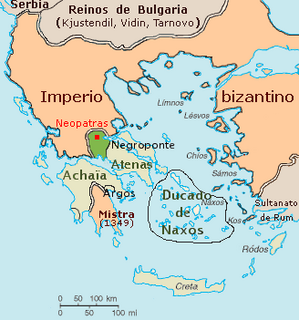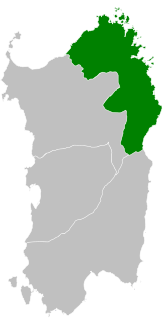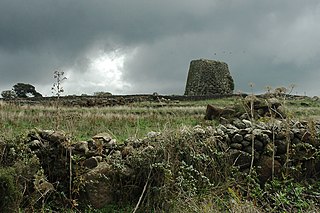
Peter IV, called the Ceremonious, was from 1336 until his death the king of Aragon, Sardinia-Corsica, and Valencia, and count of Barcelona. In 1344, he deposed James III of Majorca and made himself King of Majorca.

John I, called by posterity the Hunter or the Lover of Elegance, but the Abandoned in his lifetime, was the King of Aragon from 1387 until his death.

James II, called the Just, was the King of Aragon and Valencia and Count of Barcelona from 1291 to 1327. He was also the King of Sicily from 1285 to 1295 and the King of Majorca from 1291 to 1298. From 1297 he was nominally the King of Sardinia and Corsica, but he only acquired the island of Sardinia by conquest in 1324. His full title for the last three decades of his reign was "James, by the grace of God, king of Aragon, Valencia, Sardinia and Corsica, and count of Barcelona".

The Duchy of Athens was one of the Crusader states set up in Greece after the conquest of the Byzantine Empire during the Fourth Crusade as part of the process known as Frankokratia, encompassing the regions of Attica and Boeotia, and surviving until its conquest by the Ottoman Empire in the 15th century.

The Crown of Aragon was a composite monarchy ruled by one king, originated by the dynastic union of the Kingdom of Aragon and the County of Barcelona and ended as a consequence of the War of the Spanish Succession. At the height of its power in the 14th and 15th centuries, the Crown of Aragon was a thalassocracy controlling a large portion of present-day eastern Spain, parts of what is now southern France, and a Mediterranean empire which included the Balearic Islands, Sicily, Corsica, Sardinia, Malta, Southern Italy and parts of Greece.

The vegueria was the feudal administrative territorial jurisdiction of the Principality of Catalonia during the Middle Ages and into the Modern Era until the Nueva Planta decrees of 1716. The vegueria was headed by a veguer and its office was called a vigeriate.
John I Doukas, Latinized as Ducas, was an illegitimate son of Michael II Komnenos Doukas, Despot of Epirus in c. 1230–1268. After his father's death, he became ruler of Thessaly from c. 1268 to his own death in 1289. From his father's family he is also inaccurately known as John Angelos.

Ypati is a village and a former municipality in Phthiotis, central peninsular Greece. Since the 2011 local government reform it is part of the municipality of Lamia, of which it is a municipal unit. The municipal unit has an area of 257.504 km2. Its 2011 population was 4,541 for the municipal unit, and 496 for the settlement of Ypati itself. The town has a long history, being founded at the turn of the 5th/4th century BC as the capital of the Aenianes. During the Roman period the town prospered and was regarded as the chief city of Thessaly, as well as a bishopric. It was probably abandoned in the 7th century as a result of the Slavic invasions, but was re-established by the 9th century as Neopatras. The town became prominent as a metropolitan see and was the capital of the Greek principality of Thessaly in 1268–1318 and of the Catalan Duchy of Neopatras from 1319 to 1391. It was conquered by the Ottomans in the early 15th century and remained under Ottoman rule until the Greek War of Independence.

The Judicate of Arborea or the Kingdom of Arborea was one of the four independent judicates into which the island of Sardinia was divided in the Middle Ages. It occupied the central-west portion of the island, wedged between Logudoro to the north and east, Cagliari to the south and east, and the Mediterranean Sea to the west. To the north east and beyond Logudoro was located Gallura, with which Arborea had far less interaction. Arborea outlasted her neighbours, surviving well into the 15th century. The earliest known judicial seat was Tharros. The Judicate of Arborea at the times of its maximum expansion occupied the whole island's territory, except the cities of Alghero and Cagliari.

The Duchy of Neopatras was a principality in southern Thessaly, established in 1319. Officially part of the Kingdom of Sicily, itself part of the Crown of Aragon, the duchy was governed in conjunction with the neighbouring Duchy of Athens, it enjoyed a large degree of self-government. From the mid-14th century, the duchies entered a period of decline: most of the Thessalian possessions were lost to the Serbian Empire, internal dissensions arose, along with the menace of Turkish piracy in the Aegean and the onset of Ottoman expansion in the Balkans. Enfeebled, the Catalan possessions were taken over by the Florentine adventurer Nerio I Acciaioli in 1385–1390. The title of Duke of Neopatras was held by the heir of the King of Sicily.

Nerio I Acciaioli or Acciajuoli was the actual ruler of the Duchy of Athens from 1385. Born to a family of Florentine bankers, he became the principal agent of his influential kinsman, Niccolò Acciaioli, in Frankish Greece in 1360. He purchased large domains in the Principality of Achaea and administered them independently of the absent princes. He hired mercenaries and conquered Megara, a strategically important fortress in the Duchy of Athens, in 1374 or 1375. His troops again invaded the duchy in 1385. The Catalans who remained loyal to King Peter IV of Aragon could only keep the Acropolis of Athens, but they were also forced into surrender in 1388.
Don Alfonso Fadrique was the eldest and illegitimate son of Frederick II of Sicily. He served as vicar general of the Duchy of Athens from 1317 to 1330.
Peter (I) Fadrique, Count of Salona, was the eldest son of Alfonso Fadrique, vicar general of Athens and Neopatras, and Marulla of Verona.

Louis Fadrique a Catalan nobleman who was Count of Salona, as well as lord of various other towns in Central Greece from ca. 1365 until his death in 1382. In 1375–1381 he also served as the vicar-general of the twin duchy of Athens and Neopatras.

The Judicate of Gallura was one of four Sardinian judicates in the Middle Ages. These were independent states whose rulers bore the title iudex, judge. Gallura, a name which comes from gallus, meaning rooster (cock), was subdivided into ten curatoriae governed by curatores under the judge. In the 13th century, the arms of Gallura contained a rooster.

The Kingdom of Sardinia, also referred to as the Kingdom ofSavoy-Sardinia, Piedmont-Sardinia, or Savoy-Piedmont-Sardinia during the Savoyard period, was a state in Southern Europe from the early 14th until the mid-19th century.

The Battle of Neopatras was fought in the early 1270s between a Byzantine army besieging the city of Neopatras and the forces of John I Doukas, ruler of Thessaly. The battle was a rout for the Byzantine army, which was caught by surprise and defeated by a much smaller but more disciplined force.

Paleo-Sardinian, also known as Proto-Sardinian or Nuragic, is an extinct language, or perhaps set of languages, spoken on the Mediterranean island of Sardinia by the ancient Sardinian population during the Nuragic era. Starting from the Roman conquest with the establishment of a specific province, a process of language shift took place, wherein Latin came slowly to be the only language spoken by the islanders. Paleo-Sardinian is thought to have left traces in the island's onomastics as well as toponyms, which appear to preserve grammatical suffixes, and a number of words in the modern Sardinian language.
Boniface Fadrique was a Catalan nobleman active in Central Greece as lord of Karystos from 1359 until 1365 and then as Count of Salona and owner of various other fiefs in the Duchy of Athens from 1366 until his defeat in a conflict with his nephew Louis Fadrique in the late 1370s.
James Fadrique was a Catalan nobleman who became Count of Salona, as well as lord of various other towns in Central Greece from ca. 1355 until his death in 1366.













